Are you looking for a more unconventional and entertaining way to grow your food? Have you ever considered combining fish and plants in a harmonious hydroponic setup? If not, you’re in for a treat! Welcome to the wonderful world of aquaponics.
Now, we know what you’re thinking. “Is this some kind of crazy experiment that will leave me with a room full of stinky fish tanks?” Well, fear not, my friend, because aquaponics can actually be a clean, sustainable, and odorless way to grow your own food.
So, if you’re ready to take the plunge and add some underwater friends to your homegrown salad, join us as we dive into the fascinating world of hydroponics with fish.
Table of Contents
What Is hydroponics with fish?
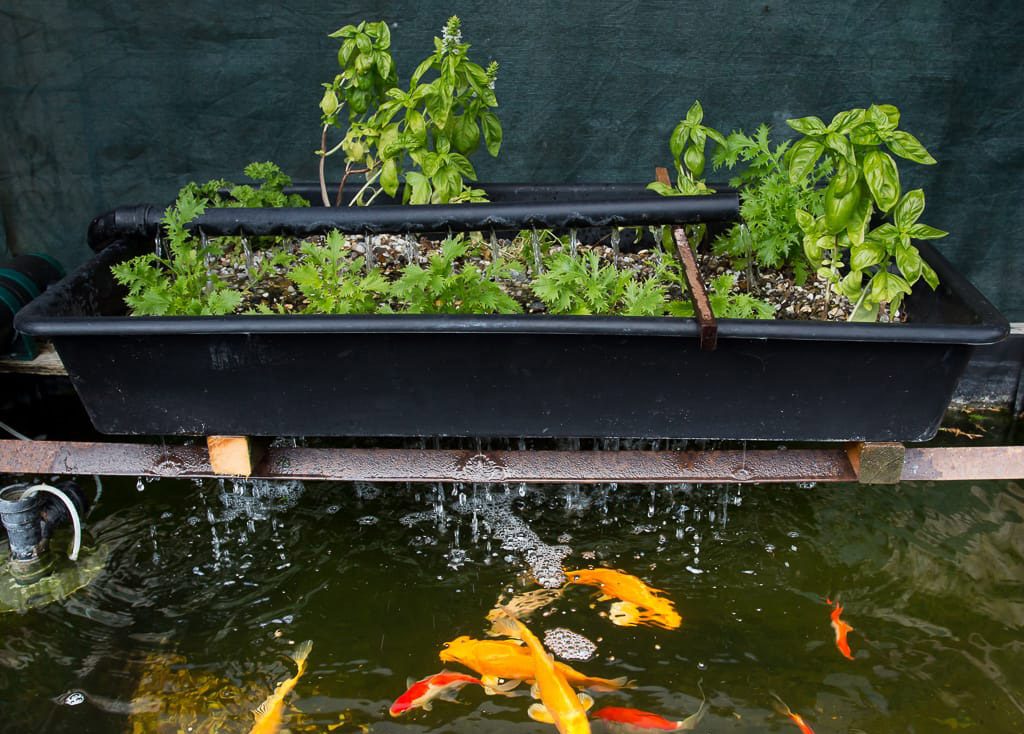
Aquaponics is a sustainable farming method that combines hydroponics (growing plants in water) with aquaculture (raising fish). The waste produced by the fish provides nutrients for the plants, and the plants, in turn, clean the water for the fish. It’s a closed-loop system that requires less water and fertilizer than traditional farming methods and can produce both fish and plants for consumption.
Why would you want/need to use such a system?
In a hydroponic system, you must replace your aqueous solution every 2/3 weeks. This prevents the over-accumulation of fungi, nutrients, and bacteria.
The same goes for an aquaculture system. Toxic nutrient accumulation occurs from fish, fish waste, and fish food. This results in you having to reintroduce a clean water supply to your setup continuously.
Aquaponics solves the above issues through a symbiotic relationship between fish and plants.
In this system, microbes in the water convert ammonia from the fish waste to nitrates which the plants then take up and use to grow. In turn, the plants act as biofilters, providing purified water that returns back to the fish tank.
This continuous, mutually beneficial cycle reduces effort and results in you having healthy fish, happy plants, and minimal water wastage.
How does an aquaponic system work?
A variety of aquaponic systems exist. They can vary in size, complexity, and setup. But every aquaponic system has three key elements:
- Fish.
- Plants.
- Bacteria.
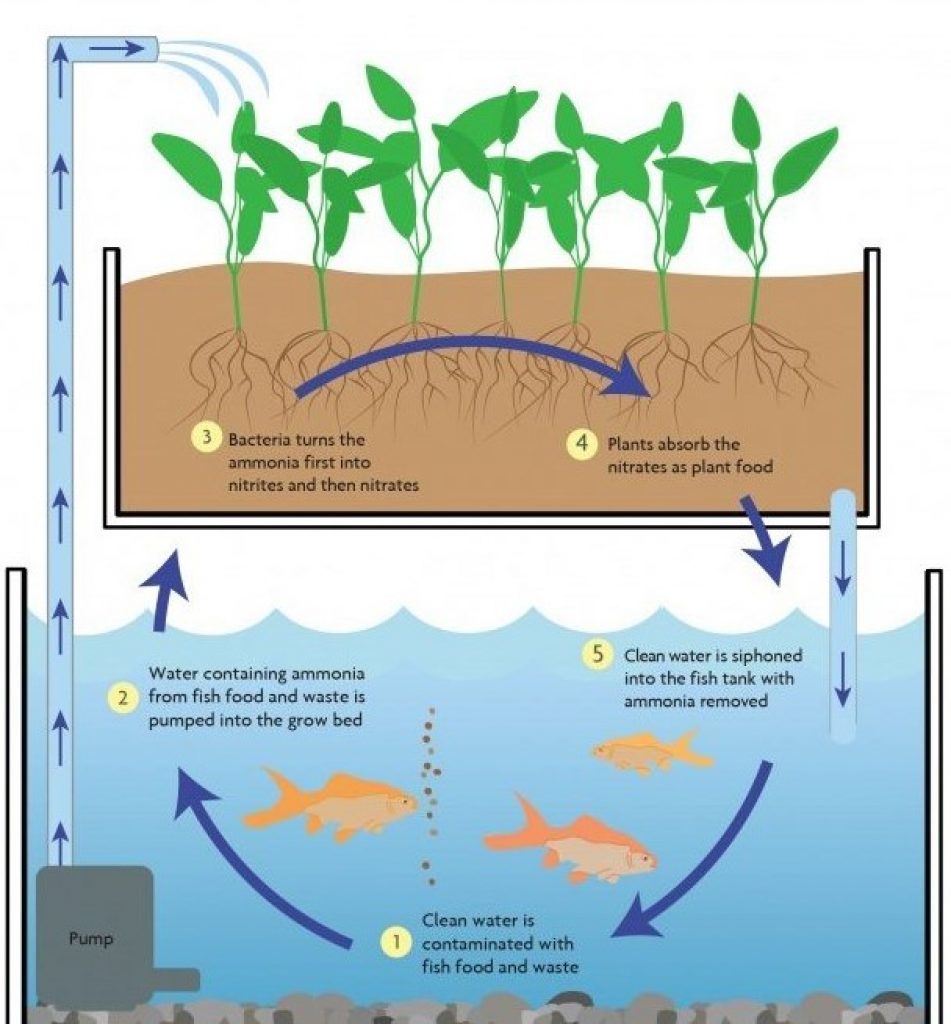
Credit to: Jilian Helvey
Source: aquaponichowto.com
Fish
Fish are responsible for feeding your plants, and as such, they play a vital role in your aquaponic system. The waste that they produce acts as a natural fertilizer.
They can be of an ornamental or food variety. Either way, selecting the appropriate fish is critical to the success of your system.
Plants
As previously mentioned, plants act as a biofilter. They detoxify the water by absorbing the nitrates and other impurities, allowing it to recirculate back to the fish. In doing so, they remove the need to replace water, continuously lowering water usage.
Bacteria
The unsung hero of the aquaponic system. The bacteria present in this system transform fish waste into nutrients for the plants through nitrification. Nitrification takes place by means of the nitrogen cycle.
The nitrogen cycle
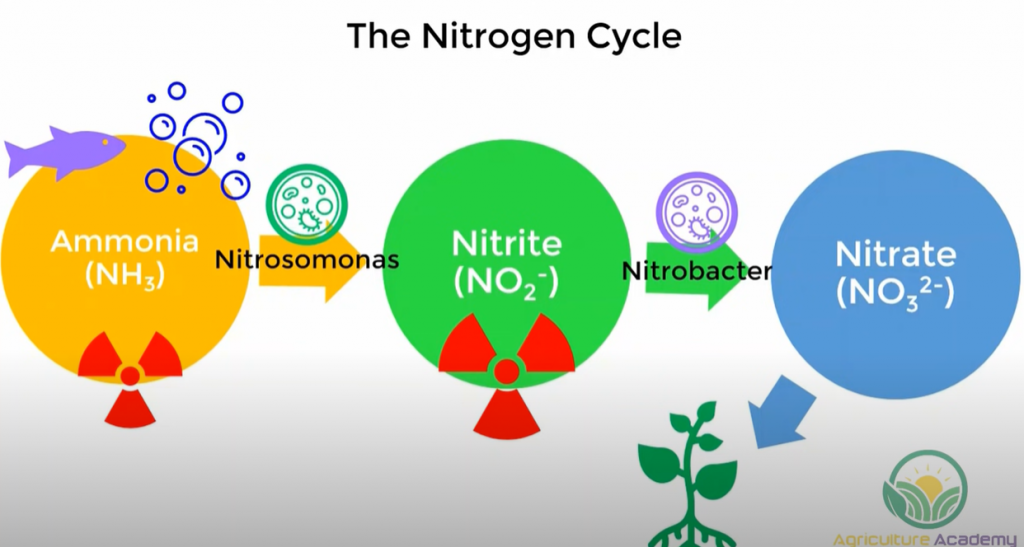
This cycle in Aquaponics follows 3 specific steps:
1. Ammonification
The first step of the nitrogen cycle is ammonia production. This occurs when fish or other aquatic animals excrete waste in the form of ammonia (NH3). Ammonia is toxic to fish in high concentrations, but it can serve as a valuable source of nitrogen for plants.
In hydroponic systems, bacteria known as nitrifying bacteria convert ammonia into a less toxic compound known as nitrite (NO2-).
2. Nitrification
The second step of the nitrogen cycle is nitrite oxidation. Nitrite (NO2-) is still harmful to fish, but another type of bacteria called Nitrobacter can convert it into a less toxic form of nitrogen called nitrate (NO3-).
Nitrate is the primary form of nitrogen that plants use to grow, making it an essential nutrient for hydroponic systems.
4. Assimilation
The third and final step of the nitrogen cycle is known as assimilation or nitrate assimilation. Plants take up the nitrate from the water and incorporate it into their tissues for growth and development.
As the plants assimilate the nitrate, they effectively remove the nitrogen from the water, helping to balance the nitrogen levels in the hydroponic system.
This step is essential for giving plants the nutrients they need to thrive in a hydroponic environment.
Basic components of an aquaponic system
If the concept of hydroponics with fish excites you, then you’ll want to know more about the equipment involved in the process.
Here are some of the basic components that make up an aquaponic system:
- Fish tank.
- Grow beds.
- Grow media.
- Biofilters.
- Water pumps.
- Electricity.
- Water heaters/coolers.
Fish tank
This is where your fish will be living.
Your fish tank should have the following characteristics:
- Sizing: Your tank must be the appropriate size for your fish species.
- Round over rectangular: Try purchasing a round tank. Rectangular tanks are prone to issues. They allow solid waste to collect and rot in corners.
- Build quality: Ensure your tank is durable and waterproof.
- Material choice: Purchase a tank made out of food-grade material.
- User-friendly: Select a user-friendly tank with a configuration allowing easy solid waste removal.
- Choose the right surface: The fish tank must be on a solid surface. Prop it up if necessary.
Recommended materials: Any appropriately sized structure that you can line with an EPDM pond liner will be suitable as a fish tank. Other options include recycled bathtubs, stock tanks, IBC tanks, and recycled barrels(DIY).
Grow beds
This is where your plants grow. The size of your fish tank determines the size of your grow beds. The bigger the grow bed and the more plants there are, the more fish waste required
Your grow beds should have the following characteristics:
- Ratio: Generally, the recommended grow bed to fish tank ratio is approximately 1:1.
- Material choice: Ensure your grow beds are made out of food-grade material.
- Robust: They must be strong enough to hold growing media and water.
Recommended materials: Grow beds can be made from the same materials as a fish tank.
Grow media
Grow media is the substance that provides structural support to the plants while holding water and nutrients for the plants to grow. Additionally, it acts as a biofilter.
Your grow media should have the following characteristics:
- Lightweight.
- Mid-sized.
- Porous.
- Neutral pH.
Recommended materials: crushed rock, hydroponic clay, aquarium gravel, or those made of synthetic materials.
Biofilters
While your media beds can serve the same purpose as a biofilter, you may wish to include a separate system as part of your design (if you have the space to do so).
Water pumps and piping
These components circulate water and oxygen throughout your aquaponic system. If it were up to us, we’d opt for a solar water pump.
Solar water pumps are a sustainable and cost-effective option for aquaponic growers who want to minimize their carbon footprint and reduce electricity costs.
Granted, they aren’t exactly cheap. But if you have the means, you’ll find these pumps more than worth it. Just make sure you size your solar water pump appropriately.
Electricity
Any pumps or lights you add to your setup require electricity, so you’ll need to link your setup to your electrical grid. Alternatively, you can use solar panels to generate the required energy.
Water Heaters/Coolers
If you live in very hot or cold regions, then you may also want to invest in water heaters or coolers.
Again, this is a perfect opportunity to integrate solar into your aquaponic setup — if you have the means. Feel free to check out our article detailing the 7 best solar water heaters in the U.S.
Types of aquaponic systems
The great thing about aquaponic growing is that you can be flexible in your approach. The system lends itself to a number of variations.
Let’s take a look at the 4 hydroponic growing methods used in aquaponics.
- Deep Water Culture (DWC).
- Flood And Drain (a.k.a. Ebb And Flow).
- Nutrient Film Technique (NFT).
- Drip Irrigation.
Deep Water Culture (DWC)
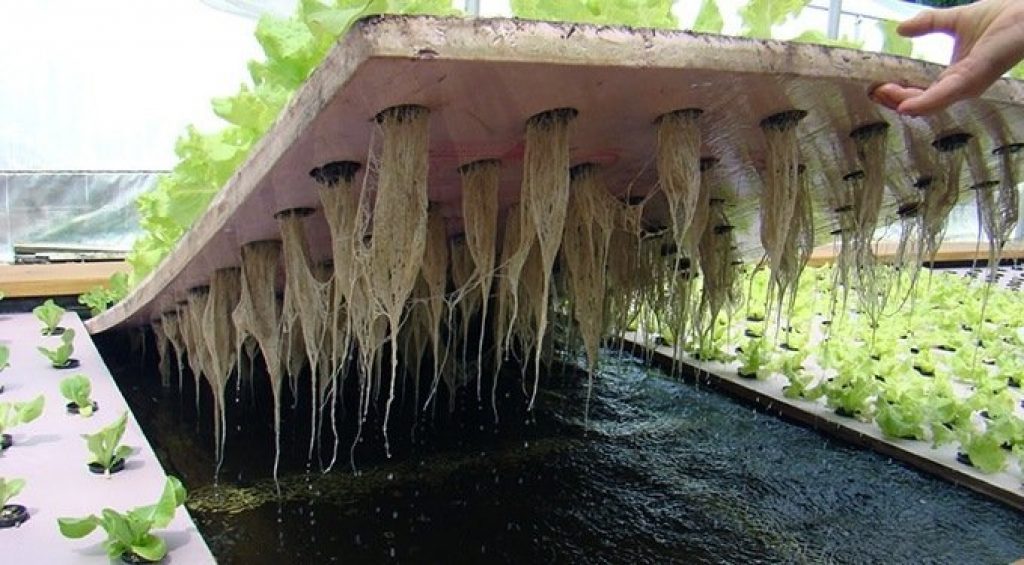
Source: Epic Gardening
Related reading: DWC Hydroponics (A Beginners Guide To Deep Water Culture)
Flood And Drain (Ebb And Flow)
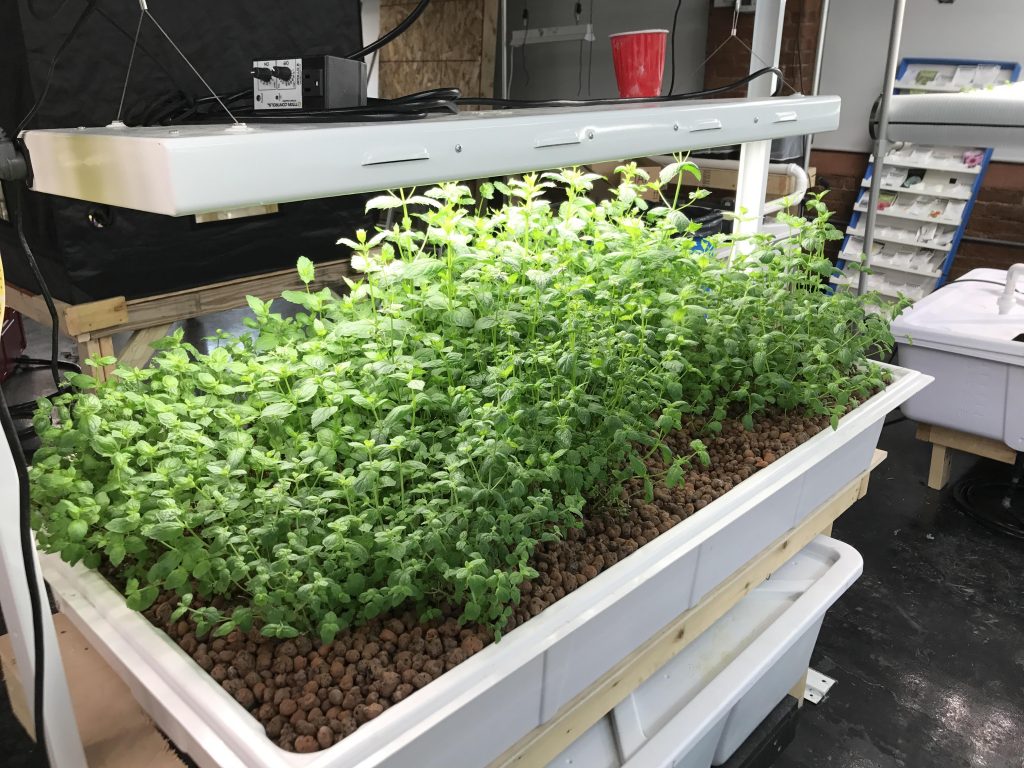
Source: AgeHans on Reddit
This system irrigates the plants by filling the hydroponic basin with nutrient-rich water, followed by a period of draining, which draws air into the root zone.
Intermittent exposure to water and air introduces oxygen to the roots, creating an optimal environment for them to flourish.
Additionally, coarse substrates such as expanded clay or perlite are used for root stability, drainage, and biofiltration.
Nutrient Film Technique (NFT)
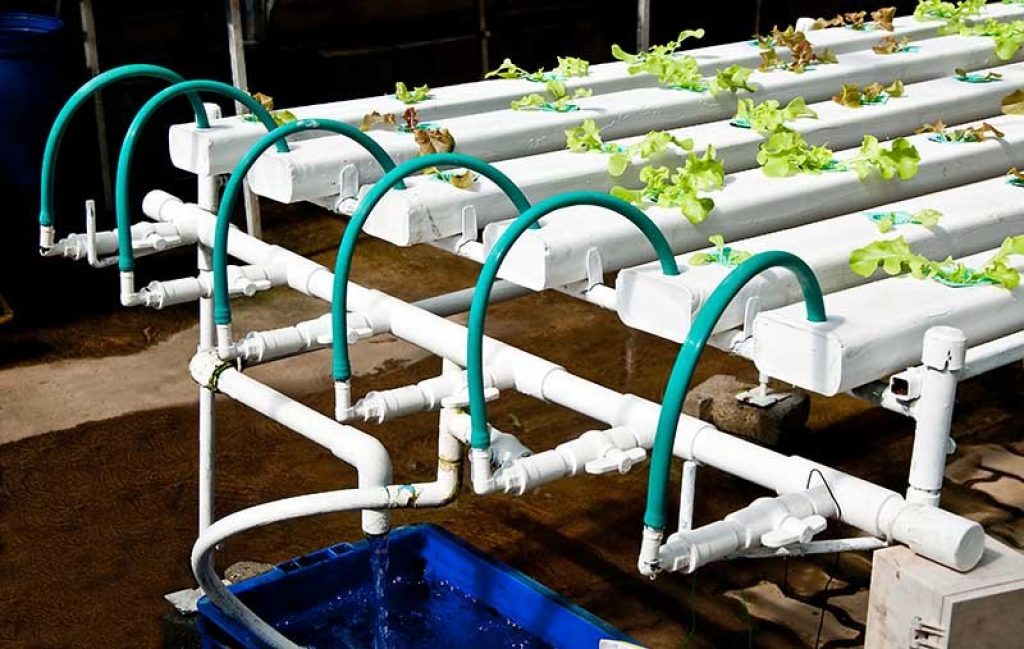
Source: Chakkapong Benjasuwan
The NFT method uses narrow channels, such as PVC pipes, to transport nutrient-rich water.
Holes are drilled into the pipes, and the plants are placed into them. In this position, their roots can hang freely and make contact with the stream of water.
This system is suited to plants that require little in the way of support, e.g., herbs and strawberries.
Drip Irrigation

This system uses growing media that provides the roots with a constant water and air supply.
Bucket (Dutch or Bato) culture is generally used for large fruiting crops like peppers, cucumbers, and tomatoes. Bucket culture combines both flood and drain and NFT. This creates a modular, mobile growing method.
Substrates involved in bucket culture systems include but are not limited to: Rockwool, perlite, and expanded clay.
What fish are best for aquaponics?
It’s critical that you understand the purpose of and plan for the fish in your system. After all, this is hydroponics with fish.
Here are some criteria that you need to consider before purchasing fish:
- Ornamental vs. edible.
- Temperature.
- Fish availability & aquaculture law.
- Maintenance requirements.
- Size & space requirements.
- Filtration.
- Breeding habits.
- Fish diet.
Ornamental vs. edible
Are you looking to harvest your fish for food or have them purely for ornamental purposes?
Species like Tilapia and Carp are commonly used for food but can be trickier to maintain. In contrast, ornamental species such as Koi and Goldfish are more forgiving and resistant to conditions and diseases.
Temperature
Fish require specific, steady temperatures in order to thrive, but different fish have different temperature requirements. Consider the environmental temperature as well as the temperature requirements of your fish before you go about purchasing them.
Fish availability & aquaculture law
Consider the availability of fish in your location. Remember, some species are only found in certain areas.
Also, be sure to read up on any fish farming laws that are applicable to your area. Not all fish are legal to be purchased and grown in some locations.
Maintenance requirements
How much maintenance are you willing to put up with? After all, your plants aren’t the only ones that need TLC, and some fish require more maintenance than others.
If you’re a beginner or someone wanting a low-maintenance setup, then a hardy species such as Koi or Tilapia will suit your needs well.
Size & space requirements
Space is important to your fish. Be sure to research the adult size of the fish that you are looking to raise and plan the size of your tank accordingly.
Filtration
Your filtration capacity will determine the number of fish that you can have in your setup. Get this wrong, and you will deprive your water of much-needed oxygen. Your fish and plants will suffer as a result.
Breeding
You’ll need to learn and plan for the breeding habits of the species that you have chosen. Some breed more easily in captivity than others, so your setup may require additional space.
Fish diet
The types of fish that you choose will determine the food that you have to buy. Be mindful of the fish food availability in your area and the projected cost of buying this food. The last thing you want to do is exceed your budget.
This also brings into question the species of fish that can be housed with one another. Some are carnivores, while others are herbivores or omnivores. Ensure that one species of fish you have chosen won’t eat or fight with another.
With all of that in mind, here is a list of 10 fish suited to aquaponic growing:
- Tilapia.
- Trout.
- Catfish.
- Carp.
- Koi.
- Goldfish.
- Bluegill.
- Salmon.
- Bass.
- Barramundi.
- Yellow Perch.
What are the pros and cons of an aquaponic system?
Every system comes with its advantages and disadvantages. Aquaponic systems are no different.
Here are some of the pros and cons associated with aquaponic growing:
Pros
- Minimal water wastage due to its cyclical nature.
- All-natural fertilizer source from fish waste.
- Produce is herbicide and pesticide free.
- Integrated system is sustainable and eco-friendly.
- Farm fish and cultivate plants at the same time.
Cons
- Aquaponic setups generally take up much more space than others.
- They can be power-hungry, particularly during winter. Water pumps, heaters, coolers, and lighting increase electrical consumption.
- The water, fish, and mechanical parts all require maintenance. This can be time-consuming.
- The initial investment can be rather expensive.
Final Thoughts
We hope you’ve found this introductory article on aquaponics enjoyable and informative.
If what you’ve read excites you, use this foundational knowledge as part of your journey into aquaponic growing.
And as always, please feel free to ask any further questions in the comment section below!

